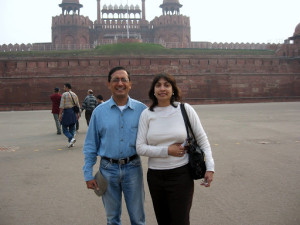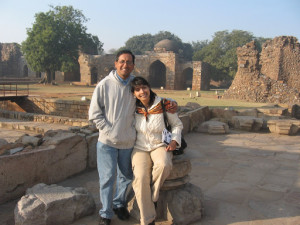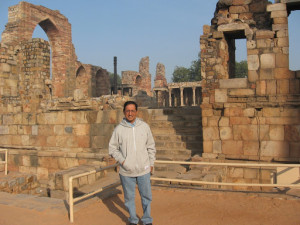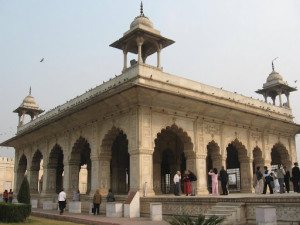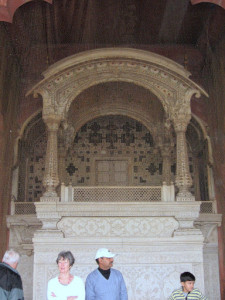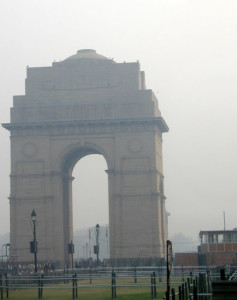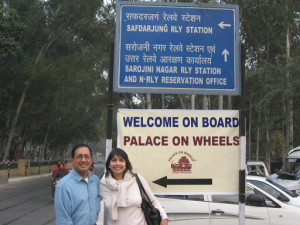There really are two Delhis—Old Delhi, at least a millennium old, studded with the tattered architectural remnants of at least seven ‘sultanates’ and New Delhi, the colonial city of Sir Edwin Lutyens and Herbert Baker, characterized by sandstone solidity and Indo-Sarasenic motifs. If you try, like we did, to visit the scattered monuments of old Delhi at dawn, long before tourist hordes have laid claim to the footprints of history, you will be enchanted and transported to a long-gone epoch when valiant Moghul troops clamored along mud trails and left behind evidence of their lasting enthusiasm for the rugged plains of India.
Strolling In the Footprints of History:
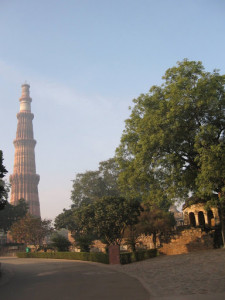
At the Mehrauli Complex that marks the location of the famous Qutub Minar (above left), the towering minaret that reaches out to the skies, I was charmed by the coalescence of three religions—Hindu, Jain and Islam as evidenced in the motifs on the granite and sandstone carvings. The eternal mystery of the iron pillar that has refused to rust will bedazzle as will the arches and columns, corridors and canopies that mark the existence of a once-flourishing society (above right). Almost magical, as is the Roman Forum when devoid of visitors, I could have stayed in this complex all day.
But other parts of Old Delhi beckoned—as at the hunkering Red Fort whose ramparts have seen centuries worth of historic happenings from the establishment of his capital by Moghul Emperor Shah Jehan in the 1600s to the arrival of their majesties George V and consort Queen Mary at the opening of the Delhi Darbar in 1911. Once inside the complex, now thoroughly equipped with security machinery including friskers who inspect each visitor for concealed arms, there is much to be learned about Islamic architecture and royal lifestyle within its precincts.
As I crossed the alleyway crammed with jewelry and clothing stores that line the old Meena Bazaar, I could almost hear the tinkle of anklets that once adorned beautiful courtesans of the harem who vied with each other to purchase the most enticing merchandise. Once inside the vast environs of the fortress, we gazed with wonder upon the main features of Islamic decorative arts that would find their fullest fruition in the majesty of the Taj Mahal in Agra. Still, the first-time visitor has an amazing introduction to marble carvings of flowers and vines, pietra dura inlay inspired by Renaissance Florence featuring semi-precious stones encrusted in non-porous marble and lace-like lattices that permit the circulation of air and allow residents to remain concealed while looking upon the passing scenes of daily life outside. In the two main buildings—the Diwan-E-Am (House of Commons, if you like) and the Diwan-E-Khas (House of Lords, for private audience with the Emperor–above left) one can see every element of Islamic design as manifested on the Indian sub-continent(below left), not to mention that tiny gem—the Moti Masjid or Pearl Mosque (below right) built for the exclusive use of the emperor himself.
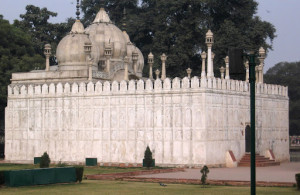
Just across the street in the busy narrow alleyways of Chandni Chowk, one of the oldest parts of Delhi in continuous use by its residents, lies the Juma Masjid, the world’s third-largest mosque, capable of accommodating 20,000 worshipers. Unlike the world’s other great mosques such as the Blue Mosque in Istanbul which is entirely enclosed, the Juma Masjid is open to the skies, its holy mihraab covered with Koranic calligraphy. As we circulated at noon through the amazingly spacious dimensions of this mosque, we felt the full weight of Indian Islam settle upon us for the sounds of the muezzin’s calls wafted around our shoulders and little boys in white skull caps prepared for afternoon namaaz. Outside on the frenzied streets, cycle-rickshaws took fascinated visitors around the maze-like tangle of allies and gullies where homes, shops, restaurants and offices sat cheek by jowl.
Lingering Amidst Edwardian Designs:
Lutyens’ New Delhi is visible, sedate and coy, behind towering evergreen yew hedges where his white-washed, squat bungalows peep shyly. His Edwardian vision for a grand capital is evident at India Gate (left) and along the promenade that extends all the way up the hill to Rashtrapati Bhavan, once the Viceroy’s Residence, now home of India’s President. Here, pink and yellow sandstone form a complex labyrinth of stolidly impressive buildings that once proclaimed the power of the mighty British Raj but currently house indigenous Indian government offices and ministerial residences. A drive past the buildings offered us a closer look as traffic flowed freely around the rotaries that brought order to Delhi’s habitual chaos.
Other samples of modern Delhi’s vibrant social life are glimpsed at Connaught Circus, the magnificent interlocking series of crescent-shaped buildings where today everything from suiting and clothing to handicrafts and handbags might be purchased. Meanwhile, on the outskirts, in the new residential ‘colonies’ that mushroomed after Independence to accommodate new settlers from areas of Sind and Pakistani Punjab, one sees the complexities of North Indian lifestyle and culture in flashy new cars and designer boutiques.
Embarking upon the Rail Journey of a Lifetime:
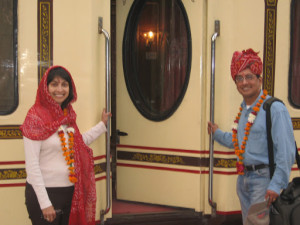
We stayed at The Claridges in Delhi, a hotel that must not be mistaken for having any kind of association with its posh, more revered namesake in London. Front Office services left a lot to be desired in this five-star hotel, though the meals we had at Pickwick’s, the restaurant on the ground floor, were outstanding. We didn’t stay there too long, however, making our move the next evening to Safdarjung Railway Station where we boarded the famous Palace on Wheels train in the midst of a great amount of welcome fanfare that included folk music, red powder tikkas on our puzzled foreheads, marigold garlands, tie and dye dupattas for the ladies and turbans for the gentlemen and an introduction to the two men who would be our personal valets throughout the trip (above right) .
Ours were Anil and Mahaveer (left) who escorted us to our cabin in the Udaipur saloon.
(For more information on the Palace on Wheels Tour, please click on the Jaipur link).
Bon Voyage!
